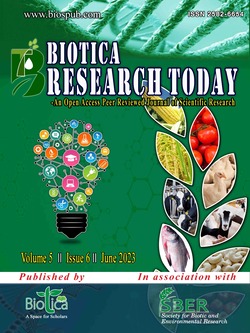
Insect Immunology Unveiled: Unlocking Mechanisms and its Potential in Pest Control Strategies
Arindam Pal
Dept. of Entomology, Post Graduate College of Agriculture, Dr. Rajendra Prasad Central Agricultural University, Pusa, Samastipur, Bihar (848 125), India
DOI: NIL
Keywords: AMPs, Eicosanoid, Insect immunology, RNAi
Abstract
Insects are one of the most diverse creatures of nature, surviving on this earth for millions of years. Insects’ capability to resist invading pathogens and infections is one of the potential reasons for their overwhelming adaptability to different environments. Insect immunity comprises several complex mechanisms and pathways. From the invasion of the pathogen to creating an immune response takes several steps, including recognition of the pathogen, channelling pathways and the effector mechanisms. Current chemical-dependent strategies for pest control are neither sustainable nor eco-friendly. So, the exploration of new and environmentally-safe pest control approaches has become an urgent need. A deep understanding of insect immunology can create such strategies by targeting the immune system of insects for biocontrol. In this article, we will discuss the fascinating facts of insect immunology by exploring the complexity of their immune systems and shed light on the potential applications of insect immunology in biocontrol.
Downloads
not found
Reference
Chen, S., Luo, X., Nanda, S., Yang, C., Li, Z., Zhang, Y., Zhou, X., Pan, H., 2023. RNAi-based biopesticides against 28-spotted Ladybeetle Henosepilachna vigintioctopunctata does not harm the insect predator Propylea japonica. Journal of Agricultural and Food Chemistry 71(7), 3373-3384. DOI: https://doi.org/10.1021/acs.jafc.2c08473.
Corey, E.J., Albright, J.O., Barton, A.E., Hashimoto, S., 1980. Chemical and enzymic syntheses of 5-HPETE, a key biological precursor of slow-reacting substance of anaphylaxis (SRS) and 5-HETE. Journal of the American Chemical Society 102(4), 1435-1436. DOI: https://doi.org/10.1021/ja00524a044.
Medzhitov, R., Janeway, C.A., 2002. Decoding the patterns of self and nonself by the innate immune system. Science 296(5566), 298-300. DOI: https://doi.org/10.1126/science.1068883.
Pallis, S., Alyokhin, A., Manley, B., Rodrigues, T., Barnes, E., Narva, K., 2023. Effects of low doses of a novel dsRNA-based biopesticide (Calantha) on the colorado potato beetle. Journal of Economic Entomology 116(2), 456-461. DOI: https://doi.org/10.1093/jee/toad034.
Shrestha, S., Park, Y., Stanley, D., Kim, Y., 2010. Genes encoding phospholipases A2 mediate insect nodulation reactions to bacterial challenge. Journal of Insect Physiology 56(3), 324-332. DOI: https://doi.org/10.1016/j.jinsphys.2009.11.008.
